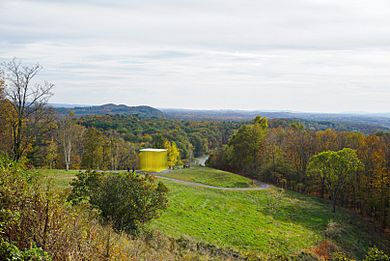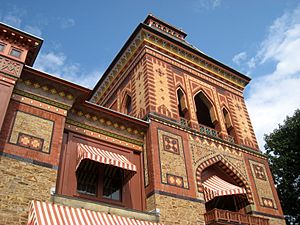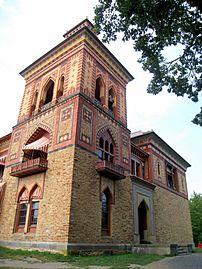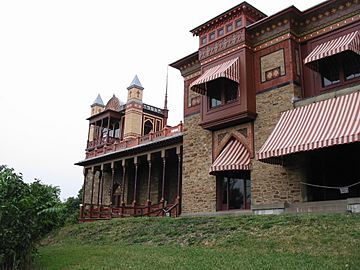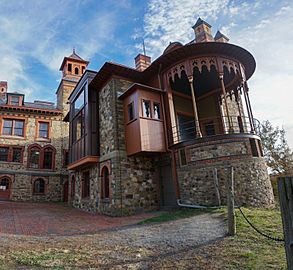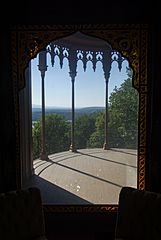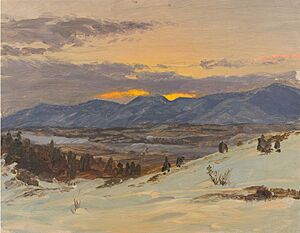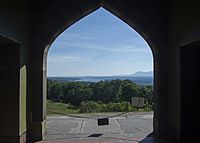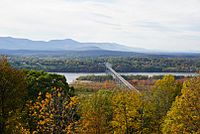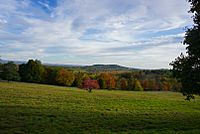Olana State Historic Site facts for kids
|
Olana
|
|
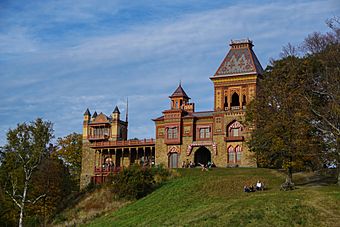
The Olana mansion
|
|
| Location | Greenport, Columbia County, New York |
|---|---|
| Nearest city | Hudson |
| Area | 250.2 acres (101.3 ha) |
| Built | 1870–72 |
| Architect | Frederic Edwin Church, Calvert Vaux |
| Architectural style | Exotic Revival |
| NRHP reference No. | 66000509 |
Quick facts for kids Significant dates |
|
| Added to NRHP | October 15, 1966 |
| Designated NHL | June 22, 1965 |
Olana State Historic Site is a special place in Greenport, New York, near the city of Hudson. It's a historic house and a beautiful landscape that was once the home of Frederic Edwin Church. He was a very important artist, known for his amazing landscape paintings as part of the Hudson River School.
The main building at Olana is a unique house that looks out over a large park and a working farm. Frederic Church designed this whole estate himself. From his home, he had incredible views of the Hudson River Valley, the Catskill Mountains, and the Taconic Range. Church and his wife, Isabel, named their estate "Olana" after an ancient fortress in Persia (now Armenia). That fortress also overlooked a river valley, just like their home.
Olana is one of the few places in the United States where you can see an artist's home, studio, and entire estate still mostly as it was. It became a National Historic Landmark in 1965. The house itself is a great example of "Orientalist" architecture, meaning it uses styles inspired by the Middle East. The New York State Office of Parks, Recreation and Historic Preservation owns and runs Olana today.
Frederic Church worked with architect Calvert Vaux to design the main house. It's built from stone and brick, with colorful patterns painted on it. The style mixes Victorian, Persian, and Moorish designs. Inside, the house looks much like it did when Church lived there. It's filled with interesting items from his travels around the world and about 40 paintings by Church and his friends. Church even designed the patterns painted on the walls and outside of the house, based on his trips to the Middle East. The house also includes Church's last art studio, which was added between 1888 and 1890.
Contents
The Story of Olana
Building a Home and Family
Frederic Church first sketched on this land in 1845. At that time, he was a student of Thomas Cole, another famous painter from the Hudson River School. Years later, in 1860, Church bought a 126-acre farm on a hill in Columbia County. It was close to the towns of Hudson and Catskill.
The first building Church added was a small country cottage. He also created gardens and orchards, dug out a swamp to make a 10-acre lake, planted many trees, and built an art studio. Frederic and Isabel Church called their first home "Cosy Cottage" and their property "the Farm."
The Churches had two children, a son born in 1862 and a daughter in 1865. Sadly, both children passed away in March 1865 from an illness. After this very difficult time, the Churches traveled to Jamaica and Vermont. They returned to Cosy Cottage later in 1865 to start fresh. Their son, Frederic Joseph Church, was born in 1866. He was one of three sons and a daughter who grew up at Olana.
Designing the Mansion
In 1867, Church bought more land at the top of his hill. He then started planning a much larger house for this new spot. After an 18-month trip to Europe and the Middle East, Church hired architect Calvert Vaux. They worked together on the design for the main mansion, which was built between 1870 and 1872.
The Churches often welcomed famous writers, artists, and business people to Olana. For Christmas in 1879, Isabel Church gave her husband books about the geography of the ancient Middle East. Soon after, they started calling their property "Olana."
Church continued to improve the property throughout his life. He designed beautiful carriage roads and added a studio wing to the house between 1888 and 1891. Even though the Churches sometimes spent winters in warmer places or time in New York City, Olana was their main home.
Saving Olana for Everyone
After Isabel Church passed away in 1899 and Frederic Church in 1900, their son Louis Church inherited the estate. Louis and his wife, Sally, kept the property much as it was. When Sally Church passed away in 1964, a nephew inherited Olana. He planned to sell it to developers at an auction.
However, a scholar named David C. Huntington led a two-year campaign to save Olana from being developed. This effort even included a cover story about Olana in Life magazine. Because of these efforts, New York State bought the property in 1966, and it was opened to the public.
The Olana Landscape
For the last 40 years of his life, Frederic Church created the 250-acre designed landscape at Olana. In 1884, Church wrote that he could make "more and better landscapes" by working on his property than by painting in his studio. Today, Olana is known as one of the most important "Picturesque" landscapes still existing in the United States. It's even been compared to Central Park in New York City, which was designed by Frederick Law Olmsted and Calvert Vaux.
Church began designing the landscape by spending three years searching for the perfect property. He had explored much of New England, but his time studying with Thomas Cole in nearby Catskill, New York, brought him back to the Hudson Valley. The Olana estate sits on several small hills, leading up to the "Sienghenbergh" (Dutch for "Long Hill"), where the main house is located. From different spots on the property, you can see the Hudson River, the Catskill, Taconic, and Berkshire Mountain ranges. You can even see parts of New York, Connecticut, Massachusetts, and Vermont.
In 1860, Frederic Church first bought a 126-acre farm. He turned it into a "ferme ornée," which means an ornamental farm. Around Cosy Cottage, he created a profitable 15.5-acre orchard and 4.3 acres of vegetable and fruit gardens. He also had pastures and crop fields, each with its own look. The family always called their home "the farm." However, Church took about half of the land out of active farming to create a landscaped park.
In this park, Church planted thousands of native trees. He also created a 10-acre lake from a swamp. He built a separate studio, a summer house, and rustic benches and railings. He even designed 5 miles of carriage drives, paved with crushed red shale from the property. Church carefully bought more land nearby until his property covered 250.2 acres, including the top of the hill where the main house now stands.
Church combined natural landforms with carefully placed carriage drives and many trees and shrubs. He did this to hide, reveal, and frame the views of his own property and the wider Hudson Valley. Visitors could drive along these roads and experience the landscape almost like watching a movie, with scenes planned by Church. The most amazing part of Church's designed landscape is the view from the main house. From there, the ground drops sharply, the Hudson River widens to 2 miles across, and the Catskill Mountains rise steeply. This view captures the majesty of nature, much like Church's famous paintings of Niagara Falls or South American volcanoes.
The Main House
The main house at Olana is a stone and brick villa with colorful painted patterns. It's a unique mix of Victorian building styles and decorative designs from the Middle East. You can see Moorish elements mixed with Italianate themes. Frederic and Isabel Church were very impressed by the architecture they saw during their travels in Beirut, Jerusalem, and Damascus in 1868.
When they returned to their farm, they changed their earlier plans for a French-style manor house. Instead, Church worked closely with architect Calvert Vaux to create his own unique vision. Church was in charge of the overall design and many of the small details. Vaux mostly acted as a consultant. Church even wrote to a friend, "I am building a house and am principally my own Architect."
The result was a house with towers and block masonry that were not perfectly balanced, but had interesting windows and porches. The outside of the house had an irregular shape, which was different from the more regular layout of rooms inside, arranged around a central hall. On the outside, Middle Eastern designs were created using colored brick, slate, ceramic tile, and especially painted patterns. Church designed these patterns himself. The painted designs continued into the main rooms on the first floor. All these different designs and themes come together to create a truly unique artistic look.
Church also designed or ordered many other special features. These included amber glass windows with cut-paper patterns and carved teak wood from workshops in India. Without an architect helping him, Church designed and built the studio wing on the west side of the house. This wing included guest rooms and a glass-enclosed observation room in the tower. Church once described his house to a reporter as "Persian, adapted to the Occident."
The furniture and decorations that Frederic and Isabel collected throughout their lives are still in the house. There are paintings by Frederic Church, as well as art by his teacher Thomas Cole and friends like Martin Johnson Heade. The dining room has a collection of older, famous paintings. The mix of furniture and decorative items includes carpets, metalwork, ceramics, and costumes from the Middle East. There's also folk art and fine art from Mexico, and fancy American and Oriental furniture. The main house at Olana is considered a great example of the Aesthetic Movement in America.
Exterior Views
Interior Views
Art Created at Olana
Frederic Church created some of his most famous paintings at Olana. He had a studio on the hill above Cosy Cottage. Throughout his life, especially in the 1850s, Church traveled across North and South America. He made oil and pencil sketches that he used as notes for his artworks. Even though Church's major paintings look like exact copies of landscapes, he called them "compositions." This means he created them from his sketches and his own artistic ideas.
In the 1860s and 1870s, Church did this work at Olana and also at his studio in New York City. Usually, he did most of his painting at Olana, then finished the artwork in New York. Church also made lively sketches of the Olana landscape itself. He even framed some of these and hung them in the main house.
In his studio at Olana, he made hundreds of pencil and oil drawings for the painted patterns, fireplaces, railings, and other parts of the main house. In the 1870s, Church developed rheumatism, which made it very hard for him to paint. He then focused more and more on Olana itself. He improved the landscape, bought artwork for the house, and built the studio wing.
Olana was one of several grand artist homes in the Hudson River Valley. Other examples included Albert Bierstadt's Malkasten and Jasper Francis Cropsey's Ever Rest.
Olana's Amazing Views
The "Viewshed" of Olana means the wide, sweeping views you can see from the property. These views start in the Hudson River Valley and reach all the way to Massachusetts, Vermont, and Connecticut. To the west, the Sieghenburgh ridge drops sharply, giving you a view of the Hudson River through trees planted by Frederic Church. West of the Hudson River, you can see the eastern part of the Catskill Mountains. To the southwest and south, the land goes down towards Inbocht Bay, about three miles away. To the southeast and east, Blue Hill rises in the distance.
In 1876, a New York journalist wrote that "There are no finer views in the world than he can command from his windows." Church spent over 30 years carefully designing the landscape. He even dug an artificial lake in 1873 to reflect the Hudson River and balance the views. He also made dozens of oil sketches of the view from Olana. Church bought the property on Long Hill specifically because of its grand views. He told his father, who was helping pay for the land, that it was important for "securing fine openings for the views."
After Frederic Church's lifetime, The Olana Partnership has worked hard to protect these views. They have stopped two large industrial projects that would have blocked the beautiful scenery. In 1977, there were plans for a nuclear power plant south of Catskill, which would have been in Olana's viewshed. A painting by Frederic Church showing the view from Olana was used to prove how important the views were. In 1979, the power company decided not to build the plant.
Later, in 1998, a company announced plans for a large cement plant near the Hudson River. Many people from the Hudson Valley and environmental groups, including Olana, protested this project. In 2005, after strong opposition, the company gave up its plans for the cement plant.
Since 1992, a group called Scenic Hudson and its partners have helped protect more than 2,400 acres in the Olana Viewshed. In 2015, they helped protect the views from a nearby farm.
Taking Care of Olana
Olana is managed by the New York State Office of Parks, Recreation and Historic Preservation. They get help from The Olana Partnership, a non-profit group. Both organizations work to make Olana look just as it did in the 1890s.
There's a large museum and archive at Olana, which was part of Church's original property. It's open to the public and has over 700 artworks by Church. It also has thousands of artworks by other artists, including paintings by Martin Johnson Heade and John Thomas Peele, and sculptures by Church's friend Erastus Dow Palmer. The archive is open to scholars and contains letters, scrapbooks, bills, and other historical papers.
The old carriage house now serves as a visitor center. An upstairs bedroom has been turned into the Evelyn and Maurice Sharp Gallery, which shows different art exhibitions, mostly from the archive collections.
Olana was closed in 2006 for a big renovation. The painted patterns on the walls were fixed, and new carpets were put in the Court Hall. Experts also worked to restore furniture, upholstery, and fabrics. Fire safety and climate control systems were improved. When it reopened in May 2007, officials said that the new equipment showed New York State's commitment to protecting this important historic landmark.
The former wagon house in the barn area now hosts educational programs. Future plans include rebuilding the wagon house and making the main barn stronger. This will help them serve as year-round centers for learning. Olana is seen as a great example of how public and private groups can work together. Olana also supports protecting its views by encouraging people to donate "scenic easements" on their properties. This helps prevent industrial projects from blocking the beautiful views.
Learning About Olana's History
Many scholars and experts have studied Olana and Frederic Church's life. David C. Huntington's work in the mid-1960s was very important. He is credited not only with saving Olana from being sold but also with making Church famous again as a key artist of the Hudson River School. Huntington believed that the sketches and paintings Church kept at Olana were important for understanding the artist's personal values.
For many years, people thought the name "Olana" came from an ancient Arabic word meaning "our place on high." However, art historian Gerald L. Carr found no proof that the Churches ever thought of this meaning. Instead, Carr believed the answer was in a book called Geographica by Strabo, which was in Olana's library. Isabel Church gave this multi-volume Greek work to her husband for Christmas in 1879. One part of this classic book describes a fortified treasure-house named Olana, or Olane. It was located on a hillside near the Araxes River in Artaxata, a city in modern-day Armenia. Carr thought the Churches started calling their home "Olana" after reading this book. Writer John Ashbery agreed, noting in 1997 that Strabo's Artaxata was thought to be one of the places where the Garden of Eden might have been. He suggested the Churches felt a connection to both the peaceful and protected qualities of ancient Olana.
Visiting Olana
Olana is located in the southern part of Greenport, New York, in Columbia County. It's south of Hudson and east of Catskill. You can reach the estate by car from New York State Route 9G, which is less than an hour's drive south of Albany. The closest Amtrak train station is in Hudson.
The grounds of Olana are open during the day all year round, and you can use the original carriage roads. Guided tours of the house are usually available Tuesday through Sunday, and on holiday Mondays, from April to October. From November to March, tours are offered Friday through Sunday. It's a good idea to make reservations for house tours. You are allowed to take photos anywhere on the grounds, including inside the house.
The Hudson River Skywalk, a walking path across the Rip Van Winkle Bridge, opened in 2019. This path connects Olana to the Thomas Cole National Historic Site in Catskill, making it easy to visit both historic places.
See also
 In Spanish: Olana para niños
In Spanish: Olana para niños
- Historic Artists' Homes and Studios






